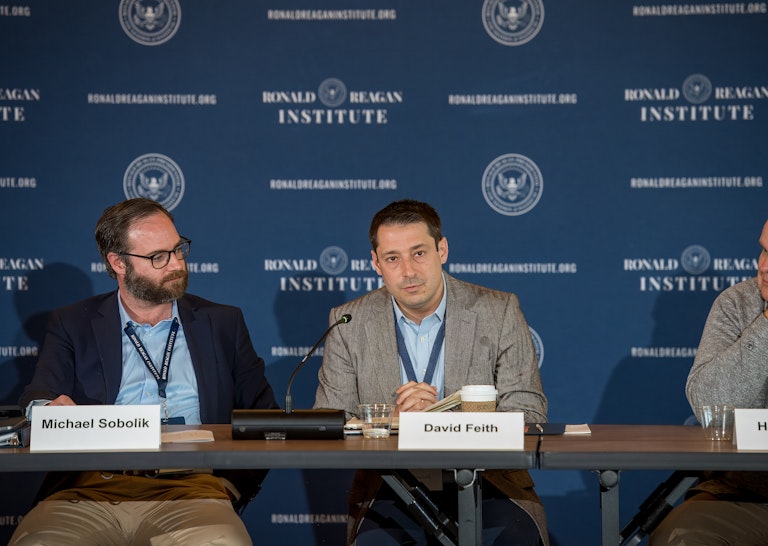Ronald Reagan Institute
A New Cold War in an Age of Doubt
By David Feith

It has been 10 years since the United States began signaling a historic shift in its grand strategy toward China. By 2015, a range of voices were urging Washington to abandon its longstanding “responsible stakeholder” approach, which posited that engagement with China would liberalize the Beijing regime and integrate it into a U.S.-led world order. Writing in The Wall Street Journal that May, I called this “The Great American Rethink on China.”[i] It was a nascent and fragile but significant turn—an accumulation of concern that could, if sustained, mark the dawn of a more effective U.S. strategy.
So it proved to be, in many ways, even more swiftly and dramatically than expected. The election of Donald Trump brought unprecedented ruptures with past policy. Trump opened the aperture for rethinking China policy in ways conventional leaders never could. Then came the Biden administration, which repudiated many Trump policies—but not on China.
All this launched a thousand headlines about Washington’s new hawkish consensus on China, the exceptional degree of bipartisan shared concern about China, and the certain dawn of a New Cold War.
And yet, a semester into the second Trump administration, we see the dynamic described by Michael Sobolik: Lacking sufficient “focus, alarm, and resolve,” Americans and their leaders are not united around “waging a systems-level competition” with Beijing. There has been no “Sputnik moment” of national awakening and mobilization. Not over IP theft, the South China Sea, Hong Kong, Xinjiang, COVID, Taiwan, Ukraine, TikTok, or any other would-be wake-up call.
In other words, after a decade, the great American rethink on China hasn’t been as great as many of us thought—or hoped.
The reasons for this are varied. Three decades of integration weren’t going to be undone quickly. China presents novel, complex problems that won’t be cheap or easy to solve. Political leaders are prone to distraction and division.
But there are deeper challenges of politics and civic culture, too: Americans today doubt our own capacity—in strength, competence, and virtue. After decades of foreign policy missteps, failed wars, deindustrialization, and the Covid debacle, public trust has eroded. Isolationism finds adherents on left and right alike. So, increasingly, does a harder-edge “woke” self-loathing that sees America as the world’s villain and harshly opposes the projection of American power.
The great American rethink on China, in other words, has unfolded alongside a great American rethink on America. The latter weighs on the former, weakening our ability to unite around causes, define objectives, make hard choices, commit resources, or sustain efforts.
The original Cold War began in the triumph, strength, and confidence of the post-WWII era. The new Cold War begins in our time of doubt, strain, and retrenchment. This imposes constraints that have been underappreciated in a lot of commentary about America’s approach to China.
So what is to be done?
1. Acknowledge political reality.
It is only prudent to assume that the current mood won’t soon go away. While Americans have shaken off malaise before—and Trump’s recent strike on Iran’s nuclear program defied expectations of isolationist limits—today’s doubt runs deep, reflecting a generational undercurrent. Hoping for a unifying “Sputnik moment” is clearly unrealistic, even as we hope to avoid a “Pearl Harbor” moment that would spur national mobilization only at dreadful cost.
Our task, then, is to build a sustainable strategy for great-power competition in the political environment we have. We need approaches that will work even—or especially—amid doubt and division.
2. Focus on modest goals, tied to domestic renewal.
Protecting U.S. sovereignty, deterring China from risking world war and global depression over Taiwan, preventing CCP dominance in strategic sectors: These are vital, politically salient goals that clearly contribute to domestic strength.
The Trump administration’s May 2020 China strategy wisely framed competition in terms of defending American interests rather than transforming China. Since then, it has only become clearer how much our victory in competition with China will depend on improving our strength and resilience at home, as the basis for continued projection of strength abroad.
3. Prioritize, in word and deed.
This may sound obvious, but it continues to be elusive, whether measured in budgets, presidential attention, legislation, or diplomacy.
A key test of prioritization is coherence. Just as the Pentagon names China its “pacing threat” for military planning, other agencies could adopt a similar north star. Trade agreements should account for China alignment as a matter of course. Agency rulemaking should similarly account for China-related concerns. Pressure on universities to curb DEI and antisemitism—rightly aimed at countering cultural currents that weaken American confidence and resolve—should avoid undermining federal support for university research that has long supported America’s technological edge over China.
4. Pick political fights selectively — including on defense spending.
The Chinese military threat is greater than the Soviet Union’s ever was, yet today we spend some 3 percent of GDP on defense—way below the original Cold War average of 7.5 percent. Defense spending is a clear U.S. priority abroad, as with the recent success in pressing NATO to embrace a new 3.5 percent defense spending target (plus 1.5 percent for related investment). But at home, we remain politically resistant to increasing our own defense commitments beyond inflation.
Failure to deter is always more expensive than preparedness. Leaders will need to make the case for stronger investment in hard power—perhaps especially in Congress, where models here include Carl Vinson, who helped drive a major expansion of the U.S. Navy amid pre-Pearl Harbor isolationism. This will require selective, principled political fights that link defense spending to the larger project of national security and industrial renewal. There is no justification for accepting the status quo as a permanent political ceiling.
5. No more lullabies—especially in tech.
Technology helped America win the Cold War against the Soviet Union and will be central again—but under far tougher conditions. America started the original Cold War as the world's leading techno-industrial power and maintained that lead throughout. Today, regulatory barriers hinder foundational sectors like energy, industrial momentum has slowed, and China outpaces the U.S. in key strategic and commercial domains.
Awareness of this dynamic is growing. Indeed Americans’ frustration with the rise of China’s industrial capacity and the stagnation of America’s is one reason why today’s Cold War begins with more anger and less optimism than the last. Yet even close observers are still often stunned by the magnitude of China’s technological strengths. In 1999, China had about 1/3 the electricity-generation capacity as the United States. Since then, while ours has been flat, China’s has grown nearly 10x, giving it a 2.5x advantage over us and rising. That industrial edge alone could prove decisive in AI deployment and diffusion.
U.S. commentary often highlights structural advantages like liberty and rule of law. These are real and valuable. But China has built long-term strengths that Americans too often overlook or underestimate, especially in techno-industrial capacity.
Effective U.S. techno-industrial strategy going forward will require clear focus on advantage (where we have it and need to maintain it, where we lack it and need to catch up), resilience (where we lack it and urgently need more), and scale (how to get more, especially with allies).
6. Sharpen policy with specific, measurable targets.
One reason U.S. policy has underdelivered is the vagueness of its objectives. We’ve spoken broadly about goals like “supply chain resilience,” but too rarely linked to clear benchmarks or deadlines. Specific, time-bound targets would sharpen focus and improve accountability. For example:
Reduce active pharmaceutical ingredient (API) dependence on China from 85+ percent to 50 percent or less by 2030.
Cut rare earth dependence on China from 80+ percent to 50 percent or better by 2030.
Prevent China from capturing more than 40 percent of global legacy semiconductor production, from 33 percent today.
Secure 30 percent U.S. onshore manufacturing of leading-edge logic chips by 2030, up from current projections of 20 percent.
7. In a crisis of belief, cultivate pockets of “faith.”
One of the most promising developments in our competition with China is the “American Dynamism” movement of technologists building companies explicitly in the national interest, in fields like weaponry, energy, and advanced manufacturing. The movement stands in opposition to Silicon Valley precedents such as Google’s 2018 decision, bowing to woke employee pressure, to refuse work on AI for the Pentagon.
We need similar moves in academia, finance, and media—sectors with vast influence but low current alignment with national strategy. In academia, the new University of Austin may be a model.
Civic education is more important than ever. As President Ronald Reagan warned: “Freedom is never more than one generation away from extinction. We didn't pass it to our children in the bloodstream. It must be fought for, protected, and handed on for them to do the same.”
[i] David Feith, “The Great American Rethink on China,” Wall Street Journal, May 28, 2025, https://www.wsj.com/articles/the-great-american-rethink-on-china-1432832888.
Join Our Newsletter
Never miss an update.
Get the latest news, events, publications, and more from the Reagan Institute delivered right to your inbox.
